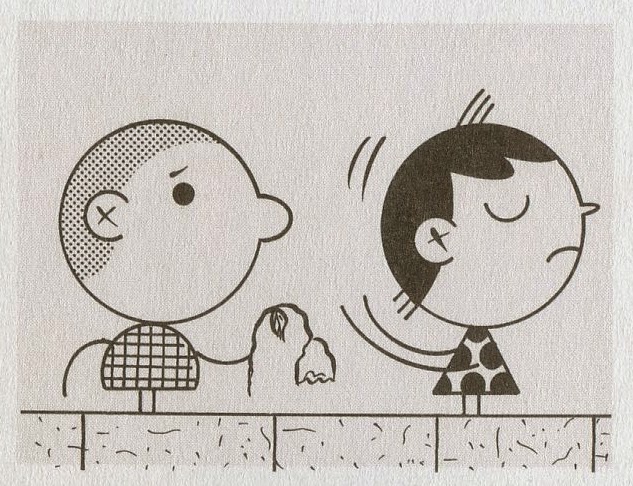 |
| From the Heart of Juliet Jones, 1966 |
Drake's audience immediately understood the joke. The girl's way of demonstrating rejection (sticking out her hand and turning her head) was so simple minded, the director's praise couldn't possibly be sincere.
Fifty years later, when it was illustrator Ivan Brunetti's turn to draw a woman rejecting a suitor, he employed the exact same body language. Only now it's no longer a joke:
 |
| Today's version of "rejection with mute futility" using circle heads |
Many people like to believe that today's comics and graphic novels are more sophisticated and mature than the soap opera strips they replaced (such as Drake's). Brunetti's work (unlike Drake's) is collected in books by the prestigious Yale University Press and translated into seven languages. Brunetti lectures in colleges and wins awards (such as The Eisner and Ignatz awards) that didn't even exist in Drake's day, when the medium was less self-congratulatory.
But take a closer look at Drake's work. Note how he assumes his newspaper audience is familiar with the story of King Priam from the Iliad. How many comparable literary references do you see in today's comics? Note too that in Drake's panel, the words are not to be read literally-- they are a lie. Only by contrasting the words with the drawing do we understand the wicked intention of the director and the lack of talent of the actress. Fifty years later it's rare to find this type of creative tension between words and drawing, in part because most artists of graphic novels and comics don't draw well enough to pull it off. Note how Drake's mastery of facial expression, body language and staging give him a range of communication tools that aren't called upon today.
Of course, Drake did employ the now unfashionable photo based realism. But if you take a look at the great variety in Drake's line, his editorial choices and expressive exaggerations, you can decide for yourself what value comes from the artist and what comes from the camera.
Whatever Drake's tools, it seems to me that he was able to achieve a result with more layers of awareness, more irony and humanity, and with greater aesthetic quality than the result we see from Brunetti and many of his peers.
So, for those of you who still enjoy good linework, this week I'm offering a collection of Drake's drawings from an era when comics were less chic, and drawings were expected to carry their own as a full partner with the words:

















Post a Comment